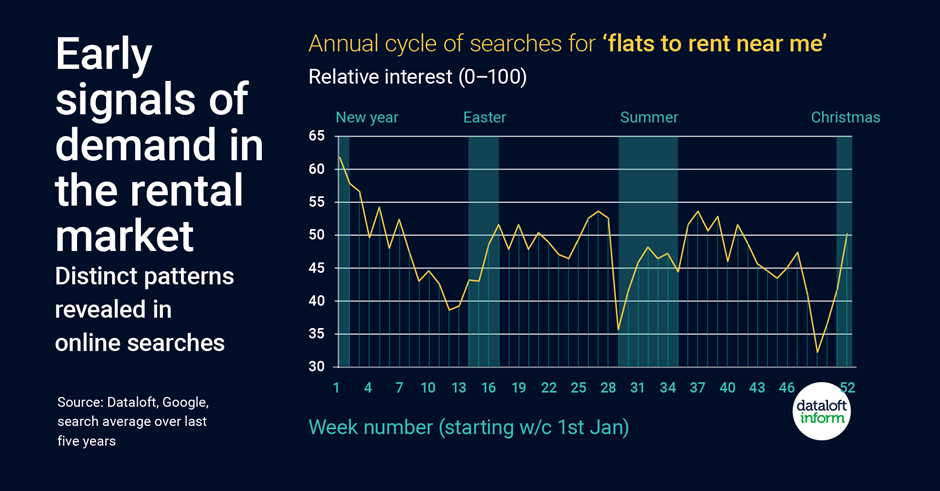The digital age has offered a plethora of tools for property professionals and access to all types of data. Now, landlords and estate agents can make informed decisions based on search patterns to gauge when the demand for property rentals will peak. In this blog, we will delve into how Google data, as highlighted by DataLoft Inform, can help landlords pinpoint the best times to release or invest in a new property.

The Seasonality of Rental Interest
Before the digital age, most property professionals relied on intuition and experience to determine when demand for rentals peaked. However, there’s a distinct seasonality to people’s interest in finding a new rental home, and it’s closely tied with annual events and holidays.
Rental patterns aren’t just about when people decide to move. They’re also influenced by external factors. Perhaps a university semester is starting, or families are moving in sync with school terms. Understanding these patterns can give landlords a strategic edge.
Unearthing Google’s Goldmine of Data
When Dataloft Inform analysed search terms inputted into Google over the past five years, a fascinating trend emerged. The query ‘flats to rent near me’ has produced a distinct pattern, pointing to specific times of the year when individuals are most likely considering a move.
By tracking this query, landlords and estate agents can get a head start. When this search term surges, it often signals an upcoming wave of leasing activity. In other words, Google is giving us an early warning system – if you know where to look.
Key Peak Periods and Their Implications
Undoubtedly, the New Year holiday is the busiest period for those exploring new rental opportunities. The fresh start mentality that comes with the New Year seems to drive individuals to consider relocation or a change in their living circumstances. This is closely followed by a secondary spike that occurs between Easter and the summer break.
On the flip side, interest wanes significantly just before Christmas and during the summer months. Presumably, during these times, prospective renters are more preoccupied with festivities, holidays, and soaking up the sun, rather than contemplating a move.
For landlords, this can be invaluable data. If a property is about to be vacated in December, it might be worth considering a short-term rental or even waiting until the New Year, when demand soars, to find a longer-term tenant. Additionally, if one is mulling over investing in a new rental property, the data suggests that gearing up around the New Year or Easter periods might yield the better returns.
Utilising Data for Investment Decisions
Beyond just deciding when to list a property, this data can be pivotal for investment decisions. Savvy investors can forecast demand and use these insights to plan their property acquisitions, renovations, and releases to coincide with these high-demand periods.
Furthermore, by aligning their investment strategies with peak rental search periods, investors can potentially reduce the time their properties sit vacant, thereby maximising rental income and return on investment.
In today’s digital age, having a property isn’t enough – it’s about having the right insights to make your property work for you. If you’re a landlord or an investor looking to leverage the power of Google data to make more informed property decisions, our team is here to help. Get in touch today and let us help you turn data into actionable, profitable strategies.

The Seasonality of Rental Interest
Before the digital age, most property professionals relied on intuition and experience to determine when demand for rentals peaked. However, there’s a distinct seasonality to people’s interest in finding a new rental home, and it’s closely tied with annual events and holidays.
Rental patterns aren’t just about when people decide to move. They’re also influenced by external factors. Perhaps a university semester is starting, or families are moving in sync with school terms. Understanding these patterns can give landlords a strategic edge.
Unearthing Google’s Goldmine of Data
When Dataloft Inform analysed search terms inputted into Google over the past five years, a fascinating trend emerged. The query ‘flats to rent near me’ has produced a distinct pattern, pointing to specific times of the year when individuals are most likely considering a move.
By tracking this query, landlords and estate agents can get a head start. When this search term surges, it often signals an upcoming wave of leasing activity. In other words, Google is giving us an early warning system – if you know where to look.
Key Peak Periods and Their Implications
Undoubtedly, the New Year holiday is the busiest period for those exploring new rental opportunities. The fresh start mentality that comes with the New Year seems to drive individuals to consider relocation or a change in their living circumstances. This is closely followed by a secondary spike that occurs between Easter and the summer break.
On the flip side, interest wanes significantly just before Christmas and during the summer months. Presumably, during these times, prospective renters are more preoccupied with festivities, holidays, and soaking up the sun, rather than contemplating a move.
For landlords, this can be invaluable data. If a property is about to be vacated in December, it might be worth considering a short-term rental or even waiting until the New Year, when demand soars, to find a longer-term tenant. Additionally, if one is mulling over investing in a new rental property, the data suggests that gearing up around the New Year or Easter periods might yield the better returns.
Utilising Data for Investment Decisions
Beyond just deciding when to list a property, this data can be pivotal for investment decisions. Savvy investors can forecast demand and use these insights to plan their property acquisitions, renovations, and releases to coincide with these high-demand periods.
Furthermore, by aligning their investment strategies with peak rental search periods, investors can potentially reduce the time their properties sit vacant, thereby maximising rental income and return on investment.
In today’s digital age, having a property isn’t enough – it’s about having the right insights to make your property work for you. If you’re a landlord or an investor looking to leverage the power of Google data to make more informed property decisions, our team is here to help. Get in touch today and let us help you turn data into actionable, profitable strategies.






